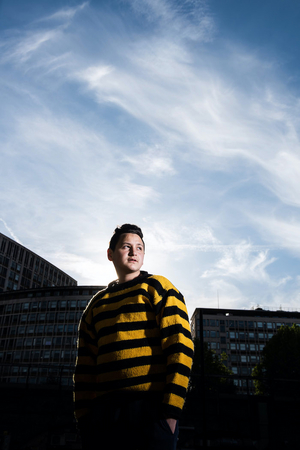Guest Blog: Assistant Director Alice Wordsworth On THE BEE IN ME

The Bee in Me flies through a day in the life of an eight-year-old boy. His home life is difficult, and to escape the harsh reality, he creates an imaginary video game.
The game allows him to transform into a bee, and we watch his imagination go wild as he flies around his bedroom and creates chaos in his classroom. However, his reality is never far away, and on completing a level, we plummet back home - a home which never has any food in the fridge and parents who are often found at the table surrounded by beer.
But he keeps flying, inventing new rules to the game and turning each challenge of life into a level to be completed. This vivid imagination is his coping mechanism to a desperate situation. And it is also our hope, as we will him on to believe in himself.
Three actors inhabit the world of the boy, to carry him through the chaos of his day. The boy remains unnamed and the characters are titled #1, #2 and #3. Thinking of the three narrators as avatars in the game, representing different aspects of the boy's imagination, fascinated us. Childhood is a time when we learn to navigate concurrent emotions and #1, #2 and #3 encapsulate this, as each reacts differently to the story.
The actors found different intentions as narrators and distinctive character traits emerged. The story is a baton passed seamlessly between the three, as they shape-shift through levels, each adopting different attitudes in response to the game.
The narrators navigate new responsibilities with each level. Sometimes the story becomes too heavy and his reality too grim, and all three shy away from playing the boy. But the baton is never dropped, however difficult a level might be; the narrators push on to get him through the day. To create this sense of flow we have been using lots of ball games and rehearsals have been movement-heavy, as the three weave together to create this one boy.
We began with a stack of questions about who this child was and what environment he was growing up in. Breaking the text into units and creating a timeline of events, we discovered: he lives in a flat, his dad has not had a job for four years, there is only beer in the fridge, and no one ever puts him to bed. These were painful truths to ascertain and we instantly felt we wanted to take care of this boy. This desire is similar to what the narrators do in telling his story: they carefully pass it between them, until he is tucked up in bed again.
To create his world, we built him a bedroom in our rehearsal room and drew a floor plan of their flat, we shared and played our childhood games, and we discussed what our bee animal incarnation would be - cultivating a process of fun and games to mirror the boy's response to the world.
The design was inspired by video games from our childhood. We were particularly drawn to a 1980s, more analogue aesthetic - the vivid Atari colours, a kind of pixelated, surreal reality. We wanted to be able to switch between the natural and digital world, the fragmented reality of the boy. The LED lights of our back wall helix to reflect this and allow us to suggest abstract locations that merge both reality and game worlds.
With no scenes and only levels to signify shifts, The Bee in Me is like one long breath. The stage is never still and the story unravels at a pulsing pace. Akin to the compulsion of playing a video game, we want the audience to get caught up in the adrenaline of the game, and, like our boy, not want to come back to reality.
The Bee in Me at the Unicorn Theatre until 1 March
Comments
Videos

